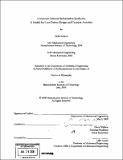| dc.contributor.advisor | David Wallace. | en_US |
| dc.contributor.author | Sukkasi, Sittha | en_US |
| dc.contributor.other | Massachusetts Institute of Technology. Dept. of Mechanical Engineering. | en_US |
| dc.date.accessioned | 2009-03-16T19:45:13Z | |
| dc.date.available | 2009-03-16T19:45:13Z | |
| dc.date.copyright | 2008 | en_US |
| dc.date.issued | 2008 | en_US |
| dc.identifier.uri | http://hdl.handle.net/1721.1/44801 | |
| dc.description | Thesis (Ph. D.)--Massachusetts Institute of Technology, Dept. of Mechanical Engineering, 2008. | en_US |
| dc.description | Includes bibliographical references (p. 173-195). | en_US |
| dc.description.abstract | The phenomenon of user-driven creation activities has recently emerged and is quickly expanding, especially on the Web. A growing number of people participate in online activities, where they generate content by themselves, freely share their creations, and combine one another's creations in order to synthesize new material. Similar activities also occur in the area of product development, as people design products for themselves and share their designs for others to reuse or build upon. The phenomenon shows that under some special circumstances, typically passive users can become active creators. Also, under such circumstances, creation activities are not just isolated do-it-yourself activities of an individual; instead, people build on one another's creations and further share their own. Recognizing the positive potential of user-driven design, this work endeavored to understand the underlying drivers of open source creation and essential environmental elements. The most important element is the commons, or shared resources, of the communities where the activities take place. A model of commons-oriented information syntheses was formulated. The model provides a unifying description of user-driven creation activities and, more importantly, serves as a general prescription for how to construct a circumstance to recreate the phenomenon for desired applications. Key aspects of the model include: that, in this particular form of information synthesis, the processes of information creating, participating in a community, and sharing of information take place integrally; that the three processes revolve around the commons; and that people consider the prospective benefits and costs of all three processes when they decide on whether or not to engage in a synthesis activity. This understanding can be employed to build circumstances under which the phenomenon can be recreated. | en_US |
| dc.description.abstract | (cont.) The ability to recreate the phenomenon of user-driven creation activities can be beneficial in many areas, including design and knowledge transfer. In the design area, the understanding can be used to build an environment that induces and fosters open-source design. With such environment, people can design things for themselves by reusing, remixing, and building on designs shared by others. They can also freely make available their own designs, which can continue to evolve through a series of building-on processes by others. In the knowledge transfer area, the understanding can be a key to constructing an environment that not only supports transfer of knowledge, but also enables people to further generate knowledge by building on what they receive, particularly when the transferred knowledge is in meta-forms such simulation models. Possible applications include: engineering education (where students can connect models of fundamental topics in various ways to create simulations of complex systems and learn from them), sustainable development (where citizens can integrate models of potential environmental remedies to figure out which solution mix will be the most effective in their situations), and academic communities (where researchers can share and allow their colleagues to reuse or build on simulation models from which the results they publish in journal papers are derived). A prototypical online environment was designed and implemented, employing the essential elements outlined in the model. Hosting a commons of environmental and energy-related simulation models, the environment functions as an open-source design environment for alternative energy systems and a public platform for generative transfers of environmental knowledge. Anyone can freely access the commons, build on them to synthesize new simulation models, and further share their synthesized models as new commons. | en_US |
| dc.description.statementofresponsibility | by Sittha Sukkasi. | en_US |
| dc.format.extent | 195 p. | en_US |
| dc.language.iso | eng | en_US |
| dc.publisher | Massachusetts Institute of Technology | en_US |
| dc.rights | M.I.T. theses are protected by
copyright. They may be viewed from this source for any purpose, but
reproduction or distribution in any format is prohibited without written
permission. See provided URL for inquiries about permission. | en_US |
| dc.rights.uri | http://dspace.mit.edu/handle/1721.1/7582 | en_US |
| dc.subject | Mechanical Engineering. | en_US |
| dc.title | Commons-oriented information syntheses : a model for user-driven design and creation activities | en_US |
| dc.type | Thesis | en_US |
| dc.description.degree | Ph.D. | en_US |
| dc.contributor.department | Massachusetts Institute of Technology. Department of Mechanical Engineering | |
| dc.identifier.oclc | 300455042 | en_US |
